Navico WR10 Wireless Pilot Controller & BT-1 Bluetooth-to-N2K gateway
Last week Navico introduced a Wireless Pilot Controller that can be added to B&G, Simrad, and Lowrance autopilots that connect to their control heads (and/or MFD controls) via NMEA 2000. It can do more than the keys indicate — like tack a sailboat that’s being steered in wind mode — and it will retail at $349 with a BT-1 Bluetooth Base Station. The WR10 remote will also be available by itself for $150 as four can work with one BT-1 at once, and eventually the remote may be able to work directly with the Bluetooth built into displays like the recently introduced Lowrance HDS Gen3 or the new Simrad Go7 / B&G Vulcan V7 twins…
This diagram shows how the full kit works. Bluetooth reliability has improved immensely in recent years, in my experience, but the reliable range is still fairly limited — the Simrad WR10 page says up to 30 meters, but I’d guess that’s in ideal conditions — and so some installs may need the BT-1 even if a somewhat distant Navico MFD has Bluetooth built in and direct mode is enabled. (I don’t know why the Pilot Controller literature consistently refers to a Micro-C Network instead of a NMEA 2000 network — which uses Micro-C connectors as standard — but I have noticed that many recent products like the NSS evo2 and Zeus2 MFDs do not seem to be NMEA 2000 Certified. What’s up with that, Navico?)
This image comes from the WR10/BT-1 Quick Reference Guide you can find at any of the three Navico brands, and it suggests that care should be taken about where the Bluetooth base station is placed in terms of interference (which I’ve noticed myself as a heavy user of Bluetooth audio streaming who sometimes gets too close to EMI). Note that the 1.6-inch diameter BT-1 case seems to be a miniature version of the case used for Navico’s multi-brand GPS/Heading sensor — though thankfully without the different names — and can be similarly mounted either flush or on a pole base.
The Guide table above shows the key actions in various autopilot modes as well as how the WRT10’s fair size red/green LED responds. I think it’s great that you get a 1 second green light assuring you that a command has been accepted by the system along with various Red signals if there’s a problem. But I suspect it will be long time before a user will see the low battery signal, as the purported power consumption is <100 mA at 12v and the source is two AAA batteries.
Incidentally, the BT-1 may be nearly the first device that can gateway Bluetooth messages onto a NMEA 2000 network — besides the ambitious but now discontinued Simrad WR20 Remote Commander — and I wonder what else could be done with a connection like this. Lowrance is already using its Gen 3 Bluetooth to run a PowerPole, and I’ve long wished that Raymarine would use its built-in MFD Bluetooth (now used for the RCU-3 remote) to create a bright waterproof touchscreen messaging interface to the deLorme inReach (I know deLorme is up for it, and now Navico’s another possibility). What would you like your marine electronics to do with Bluetooth?
I got to see the WR10 remote in action during the Navico writers event in January and it seemed to work just fine. In retrospect, I don’t know if it was using a BT-1 Base Station or a direct connection to the Vulcan V7 that was also being demonstrated, but that’s also pilot control on the big B&G Zeus2 Glass Helm in the background above. That’s how it is when ap control is distributed everywhere over N2K (as long as it’s all the same brand), and it’s great. I was also pleased to get the photo below. There’s got to be a first one of anything, and apparently I saw WR10 #1 in Florida.


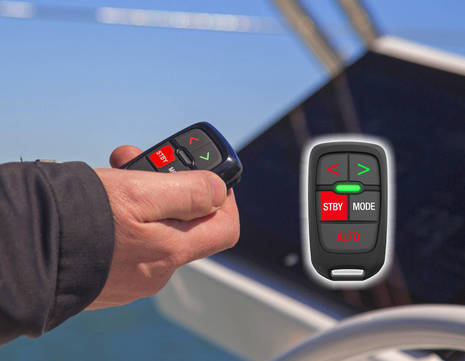
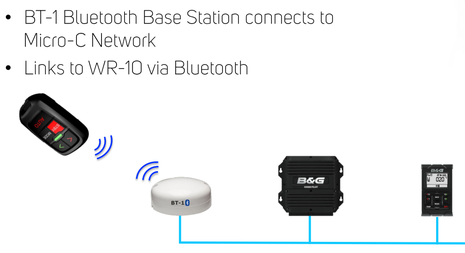
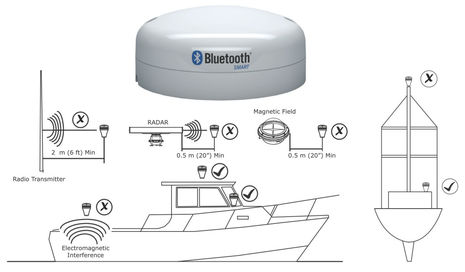
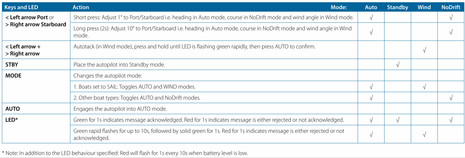
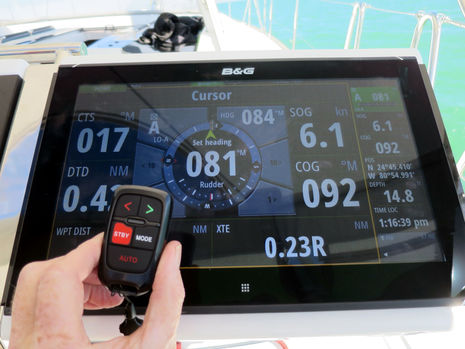
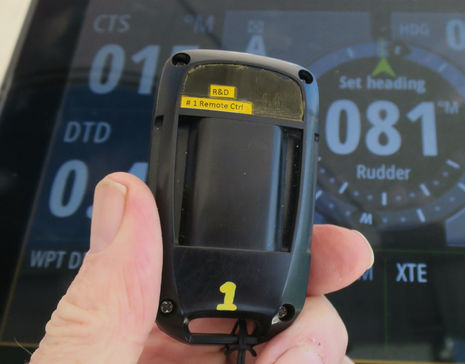











Yea, this would be nice.. Too bad, they will not have it out and working until October or December! I am sure they will sell it next month, ship it in July, but the software will not honor its existence until the end of the year. At least that’s in keeping with history. I mean, my RS35 radio was rubbish until the update came out three months after I installed it. Now my Autopilot NAC-1 computer is wasting space under the helm because, even though I bought it, installed it, my HDS touch displays will not see it until an update. Would have been nice to know before I bought it, and installed it! Navico has come a long way, and for the price, you cannot beat it, but honestly Navico, do not sell something, then once 100s of us have bought it, say, sorry, you have to wait for software! Almost makes me think about going back to Garmin… Almost…
Hi Ben,
Sorry, less than 100ma at 12v is not gonna last long with two AAA batteries..:-) I’m thinking the
Good point, Hartley, but at least “Bluetooth Smart” is another name for Bluetooth LE (Low Energy) and hopefully that bodes well for the remote:
http://en.wikipedia.org/wiki/Bluetooth_low_energy
cmgreeniv, I don’t think it’s realistic to judge Navico product releases on the RS35 VHF, which was definitely troubled and still isn’t completely right. And aren’t you one of the first boaters on the planet to have a Lowrance NAC-1?
I don’t understand why half my post was removed.. let’s see what happens here. You are right, Ben – bluetooth shouldn’t need much energy.
Hartley, it was the “less-than-symbol 100mA…” you first used and I fixed it. The comment parser thinks that a “less than” symbol is the beginning of an HTML style tag and won’t show anything until it sees the “more than” symbol.
Gotcha! I’ll stay away from funny symbols in the future..:-)
The manual on my new raymarine e125 shows an autopilot remote communicating to the MFD using bluetooth.
A very nice looking product and just what I wanted. I have been enviously looking at NKE pilots for years for this feature.
However, NKE’s unit is also a MOB fob. I wish Navico would have done this as well. Theoretically, it could still be done in software alone as all the hardware components are there, including external alarm wires on many or all of Navico’s MFDs and autopilot computers, but I doubt it will happen.
The critical point in my opinion is reliability and protection against interference of the receiver to avoid the pilot computer going to standby unintentionally. I don’t mean to get on everybody’s nerves about open ocean voyages all the time but you wouldn’t want a broken boom because of a crash gybe in the middle of the night and you wouldn’t want to beach your boat like Jeanne Socrates did (with a Raymarine pilot).
When on long sea passages I would want the receiver to be disconnected (unless this system does become a MOB fob in the future) and my install would have to provide for that.
I will follow this entry and if I don’t hear bad things (like I have for the WR20), I will probably go for it.
Dan, I checked the Raymarine manual and the only Bluetooth reference is to the RCU-3 remote, which does screen and audio commands, not autopilot. Ray definitely has wireless AP controls, the S100 and SmartController mentioned in another recent entry about wireless controls…
https://panbo.com/archives/2015/03/wireless_autopilot_controls_madman_for_raymarine_si-tex_srs-100_for_any_brand.html
…but I can’t find install info for them on the Ray site, nor is Bluetooth mentioned in the SmartController user manual.
Yes Ben, I am one of the first to have it and install it. I spoke to Lowrance, and they at first told me I did not have it…. They were surprised because they said they had not even gotten them to play with yet in the call center. I figured it would be buggy, and I don’t mind that. That’s what I get for getting stuff first. But I expected my hds touch to at least see the unit on the network, which it does not. Talking to Lowrance, the HDS will not see it until the next update. Which they say is end of this month, I will keep my fingers crossed, until then, its my simrad AP16/AC10/running off a heading from the point 1 NMEA 2K antenna. Which again, according to Lowrance, does not work. (it actually works VERY VERY well, actually more accurate than my old RC42 heading compass that broke.) I like Navico products, they work great, and I have had three separate friends that have swapped over to Lowrance HDS series from Garmin and Hummingbird in the last year after playing with our lowrance setups. Honestly this Lowrance Autopilot is priced way low. Just the 4 way NMEA block, NMEA power, and three drop cables are valued at $200. Factor that in with the NAC-1, the pump, point 1, and the hoses, I honestly do not know how Lowrance is making even 10% on that package at $900. Keep up the good work! I check panbo.com almost as much as the weather!
+1 on the MOB comments. A very obvious omission versus NKE.
Word this morning from our Navico inside rep, WR10 shipping in June, Vulcan early May.
I also questioned no MOB feature, but it is a slippery slope. What if you can’t get to the fob before the boat is out of BT range, or if MOB triggers when the fob falls off the BT connection, false alarms?
Then the question – what is the MOB action on board? Does the pilot just go to standby, come head to wind, just put a mark on the MFD? The first two options could be dangerous for anyone left on board.
I’m going to agree that Bluetooth is the wrong radio tech for MOB – the range is too short and the vulnerabilities too high to entrust it to this duty. Even in the autopilot mode, you will want to check all the coverage areas you might need BEFORE you trust it to work.
On ATSA, I can easily get my iPhone and Bluetooth earpiece out of range, just by leaving the phone at the nav station and walking back to the aft stateroom – lots of metal and electrical stuffe in between.
Bluetooth is the wrong tech for MOB! There are already standards setup, and well down the road. I think NMEA 2K for MOB was finalized in Sept of 2013. Swapping to Bluetooth now, would be problematic at best. With all the devices planning to use Bluetooth in the next three years, I would not really even want the Autopilot remote running BT, but that’s where it is right now. The liability would be huge when captain morgan, falls off his boat, then the autopilot proceeds to turn his boat around and run him over. I would be more interested in seeing the Navico version of http://oceansignal.com/products/mob1/ honestly. I want my MOB device to communicate with all boats right around my location, not just those of us who are on the tech edge sticking Bluetooth antennas on our boat just because we have the space. I am proud to say, my wife could (I make no prediction as to WOULD) turn our 50 foot beast around, and come get me, but many of my friends wifes would not even find the throttles, let alone the shifter and radio.
Thanks, Charles, but there is no standard wireless protocol for NMEA 2000. I’m not saying that Bluetooth is great for MOB alarms but a device like the WR10 could use a Bluetooth bridge like the BT-1 to put a standard N2K MoB PGN (message) onto the wired N2K network and then to all displays that understand the PGN. It’s not an either-or situation.
Similarly, AIS MoB devices like the Ocean Signal MOB1 transmit over VHF to AIS receivers which then put out NMEA 0183 (and often 2000) messages that can be displayed a AIS MoB targets. The MoB1 can also alarm the mother boat (and in some regions all nearby boats) using a regular VHF radio’s DSC abilities, which can also be distributed via NMEA 0183 and 2000.
I know it all seems terribly complicated but there are good reasons it’s all happening and already there are simple, effective MoB systems using different technologies for different sorts of boats and boating.
And you’re right that training for such situations is at least as important as the gadgets involved.
But we are also wandering off track. Let’s try to get this conversation back to the Navico autopilot remote.
I just made some corrections in the first and second paragraphs because I learned that using the WR10 remote directly with an MFD that has its own Bluetooth is not a done deal. It may be possible eventually, but for now the WR10 only works with the BT-1 Base Station.
What confused me is the fact that you can buy a WR10 by itself, but that’s because one BT-1 can be paired with up to four of the Bluetoot remotes at once.
I don’t suppose the WR10 would work with my existing WR20 base station would it? The “ambitious” but unrealized potential of the WR20 makes it a lot more fiddly than it needs to be.
Word I’ve been given is the WR10 fob will not work with the WR20 base unit. Best course of action for the WR20 is to send it deep. It has been one of the most problematic devices we’ve worked with. I am eagerly waiting on the WR10 to fix what has been a gaping hole in Navico’s pilot line.
Sorry Ben, I should have been more clear. I was not saying I thought there was a standard wireless protocol for N2K, I was saying there was a standard for N2K for MOB for the PNGs. While it did not directly reference the type of communication, it clearly stated something to the effect of using a proven marine communication technology. Which IMO is NOT Bluetooth. Totally with you on getting back to the navico autopilot discussion. I still stress my first point, of “if they say June, they mean December…” As I sit here hitting the refresh key on lowrance.com waiting for my HDS 2 Touch software update so my NAC-1 Autopilot computer will be seen by my network… 🙂 Lowrance/Navico/Simrad/BG makes some good stuff, we are just spoiled. I want a MOB button on my Autopilot remote control that will deploy my drone directly to me in the water and bring me a life jacket with a handheld vhf. I will procure the WR10, but not until December.
Hi
just finished installing same autopilot with same rude awakening of the infamous “software issue’wonder if as a “temporary semisolution” this unit could be controlled on a very simple fashion without graphics or programming with a Navico WR10 Wireless Pilot Controller & BT-1 Bluetooth unit, or perhaps the wired controller Simrad offers.
Any thoughts?
thank you David
Just a small success story about the WR10… I bought the WR10 to use on one of our boats that has Simrad NSS, and the AC12/AP28. I hadn’t had a chance to install it on that boat, so I thought I would try it on our other boat that has Lowrance HDS Gen 1 and the Simrad AC12/AP28. I didn’t know if it would work, but it does. The lowrance does not see it in the network, but once I hooked it into the network, and paired the remote, it works great!
We were on the water for a couple days (running survey lines so constantly adjusting the autopilot) and it performed great. It does take control of the AP head, so you have to go to standby and back into auto if you want to switch back to the head from the remote.
I have no idea yet on the battery life. The only two things I would like to see is a way to put it to sleep/off when not in use so it’s not using the battery waiting to reconnect (other than removing the battery). Also the screws are to access the batteries are TINY… (we all know how tiny screws and boats mix).
Hello,
I see many problems with that new remote :
– first of all the Mob is useful when you are alone and even 30ft is too short to be useful : why navico do forbid to take control of the autopilot through the gofree ? Or at least let the customer choose !
– no screen and no data information so no way to know if the order (cog change for example) was really done
– the Bluetooth is really touchy when lot of other Bluetooth device are around ( eg cellphones)…. We experience the same troubles with wr20
Aron,
If you need to press Auto to regain control from an AP28, check the firmware version & update it! I had the same on my AP24 but this was fixed in the latest version (1.3.2). See http://www.simrad-yachting.com/en-US/Support/Downloads/AP28-Autopilot-Software-Update/
The WR10 is likely to be using Bluetooth 4 Low Energy, which is does not need a permanent connection like the previous BT versions, so the remote does not need an “Off” button. Also, it is MUCH less “touchy” in terms of interference from other devices.
Team,
I have a Simrad AP25 and AC20 AP system. I have no remote. I was told that I could upgrade firmware and software using the part numbers below from Simrad Dealer.
This would allow me to use a WR20. As it was commented on, this no longer exists and was problematic anyway.
I would like to purchase the WR10. I have a working NEMA2000 network. I have Coastal Explorer sending sentences to the AC20 successfully running the AP25.
Without upgrading the AP25 and AC20, would WR10 provide the correct sentences to the Simrad AP25. There is no indication on the Simrad website that the AP25/AC20 is supported by the WR10
Here is the part numbers for software/firmware upgrade from Simrad. Both the AP20 and AC20 are running SW version 1.2.01. Simrad wants the AC20 to be version 1.3.00 and the AP25 to be at 1.2.01.02 for the WR20 to even work.
AP25 Control Unit Programming Kit: P/N 22088595
AP25 Control Unit Software: P/N 22088199
Thanks so much!!
WR10 is only compatible with AC12, AC42 and NAC-1 autopilot computers. You need WR20 for AC20.
After 8 months of using the WR10 with our NSO EVO2 system tied to Yamaha 350s through Simrad gateway / Autopilot I am quite pleased. When tired it lets me sit back in helm and use the WR10 as remote steering controller. It lets me cycle between NF and A modes on Autopilot
Captain Richard
Thank you very much for this report Richard. I was waiting for just such a feedback.
Hi I just installed Simrad autopilot remote controller Wr10 with BT1 with simard NSS16 evo2. I succeeded to pair both units. The stand by and auto buttons in the remote are working, ie green LED is flashing. When I press red and green arrows for left and right, the red LED is flashing indicating no connection. Any idea how to fix, I will really appreciate your help.
Ash, an informed reader emailed me wondering if you had tried repairing the WR10?
Hi all, any news on whether the WR10 stand alone control, that is without the base station, can connect directly to NSS EVO3 units?
Hipath,
No that is not possible. You need the BT-1. Note that it does not communicate at all with an MFD — it communicates with an autopilot computer.